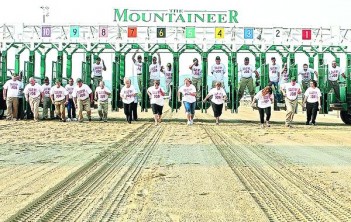
Mountaineer racing department employees break out of the starting gate in a recent attempt to defeat a proposed smoking ban for Hancock County. Their T-shirts read “Save My Job.” Facilities, slots, marketing and food and beverage employees also have participated in the publicity campaign.
NEW CUMBERLAND, W.Va. — With the Hancock County Board of Health expected to vote on a county-wide smoking ban next week, public debate continues to center on the potential economic – rather than health – effects of the policy.
The board meets at 12:30 p.m. Tuesday at the New Cumberland Municipal Building.
Opponents of the proposed ban on smoking in public places worry it will have a negative impact on the tourism and gaming industry in Hancock County, especially Mountaineer Casino, Racetrack & Resort – the county’s largest employer – as well as veterans’ organizations and limited video lottery parlors. Supporters of the Hancock County Clear Air Regulation point to the health benefits of eliminating secondhand smoke in public places.
This week, Mountaineer, among the most vocal opponents of the ban, upped its campaign by having employees don “Save My Job” T-shirts and break out of the racetrack starting gate. The campaign is intended as a show of unity to the community, Mountaineer General Manger Chris Kern said.
“While we await the final decision of the board, our employees continue to pull together to safeguard their jobs with these types of efforts,” Kern said. “We are all hopeful that the economic impact of a smoking ban on the state, county and Mountaineer will be considered at the time of the vote and that certain exemptions will be allowed.”
Kern recently met with Hancock County Health Department Administrator Jackie Huff to reiterate the “concessions” the casino is willing to make in exchange for certain policy exemptions. For example, Mountaineer would make “reasonable accommodations” for nonsmoking employees who don’t want to work in smoking areas of the building, Kern said, and would be willing to make 80 percent of its hotel, 10 percent of the gaming floor and 100 percent of its other public areas – restaurants, trackside areas, banquet and meeting facilities, the Harv, the spa and the gift shop – nonsmoking.
Hancock County Commissioner Jeff Davis estimates the smoking ban, coupled with the planned November opening of a racetrack and casino in Austintown, Ohio, could cost the county $1 million in annual revenue – an amount he said they can’t afford to lose. He hopes the board will delay enforcement of the ban for a year to allow time to assess the potential impact.
Commissioners Michael Swartzmiller and Dan Greathouse said they have concerns, but they’ll respect whatever decision the health board makes.
“It’s a health board. … I would think they would make a decision based on health facts,” Swartzmiller said, noting he would support some sort of phase-in for the policy.
New Cumberland Mayor Linda McNeil – a nurse by profession – said that while she recognizes the dangers of smoking and secondhand smoke, she does not support a “total” smoking ban and would rather see the health board focus on educating young people about those hazards.
The proposed draft of the smoking ban, approved in July, applies the rule to all restaurants, bars, gaming facilities, private clubs, hotels, motels, restaurants, bingo operations, fire department facilities, retail stores, tobacco businesses, concert venues, sports arenas, bowling lanes, all places of employment and other enclosed public places. It also bans smoking in public parks, including pavilions, playgrounds, fairs, festivals, outdoor service lines, outdoor serving areas of restaurants and other outdoor public places.
Any designated outdoor smoking areas would have to be at least 20 feet from an entrance, exit or ventilation unit, according to the policy. No-smoking signs would have to be posted in all areas covered by the policy.
To read more from The Intelligencer/Wheeling News-Register, subscribe here.






